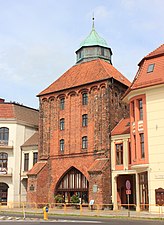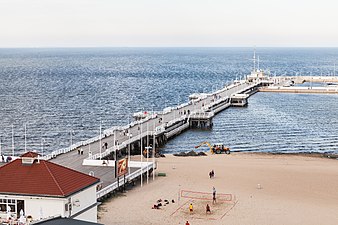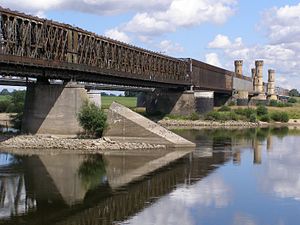world.wikisort.org - Poland
Pomeranian Voivodeship, Pomorskie Region, or Pomerania Province[2] (Polish: Województwo pomorskie [vɔjɛˈvut͡stfɔ pɔˈmɔrskʲɛ]; (Kashubian: Pòmòrsczé wòjewództwò [pvɛˈmvɛrst͡ʃi vɛ.jɛˈvut͡s.tfɔ]), is a voivodeship, or province, in northwestern Poland. The provincial capital is Gdańsk.
Pomeranian Voivodeship
Województwo pomorskie | |
|---|---|
Voivodeship | |
 Flag  Coat of arms Brandmark | |
 Location within Poland | |
| Coordinates (Gdańsk): 54°22′N 18°38′E | |
| Country | |
| Capital | Gdańsk |
| Counties | |
| Government | |
| • Body | Executive board |
| • Voivode | Dariusz Drelich (PiS) |
| • Marshal | Mieczysław Struk (PO) |
| • EP | Pomeranian constituency |
| Area | |
| • Total | 18,293 km2 (7,063 sq mi) |
| Population (2019) | |
| • Total | 2,337,769 |
| • Density | 130/km2 (330/sq mi) |
| • Urban | 1,486,267 |
| • Rural | 851,502 |
| ISO 3166 code | PL-22 |
| Vehicle registration | G |
| HDI (2019) | 0.892[1] very high · 3rd |
| Website | http://www.woj-pomorskie.pl |
| |
The voivodeship was established on January 1, 1999, out of the former voivodeships of Gdańsk, Elbląg and Słupsk, pursuant to the Polish local government reforms adopted in 1997. It is bordered by West Pomeranian Voivodeship to the west, Greater Poland and Kuyavian-Pomeranian Voivodeships to the south, Warmian-Masurian Voivodeship to the east, and the Baltic Sea to the north. It also shares a short land border with Russia (Kaliningrad Oblast), on the Vistula Spit. The voivodeship comprises most of Pomerelia (the easternmost part of historical Pomerania), as well as an area east of the Vistula River. The western part of the province, around Słupsk, belonged historically to Farther Pomerania. The central parts of the province belong to Pomerelia, including Kashubia, named after the Kashubian minority. The eastern bank of the Vistula, nowadays called Powiśle (Vistula Plains), belongs to the historical region of Prussia.
The province is one of rich cultural heritage. The Tricity urban area, consisting of Gdańsk, Gdynia and Sopot, is one of the main cultural, commercial and educational centres of Poland. Gdańsk and Gdynia are two of the major Polish seaports, the first erected by Mieszko I of Poland in the Middle Ages, the latter built in the interwar period. Amongst the most recognisable landmarks of the region are the historic city centre of Gdańsk filled with Gothic, Renaissance and Baroque masterpieces, the Museum of the National Anthem in Będomin, located at the birthplace of Józef Wybicki, poet and politician, author of the national anthem of Poland, the largest medieval churches of Poland (the St. Mary's Church in Gdańsk and the Cathedral Basilica of the Assumption in Pelplin) and the Malbork Castle. The voivodeship also includes the narrow Hel Peninsula and the Polish half of the Vistula Spit. Other tourist destinations include Wejherowo, Sopot, Jurata, Łeba, Władysławowo, Puck, Krynica Morska, Ustka, Jastarnia, Kuźnica, Bytów and many fishing ports, lighthouses, and boats.
The name Pomerania derives from the Slavic po more, meaning "by the sea" or "on the sea".[3]
Cities and towns

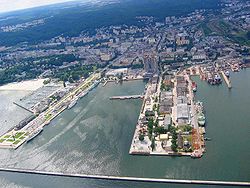
The voivodeship contains 7 cities and 35 towns. These are listed below in descending order of population (official 2019 figures).[4]
- Gdańsk (468,158)
- Gdynia (246,244)
- Słupsk (90,769)
- Tczew (60,120)
- Wejherowo (49,652)
- Starogard Gdański (47,775)
- Sopot (35,827)
Towns:
- Rumia (49,160)
- Chojnice (39,890)
- Malbork (38,465)
- Kwidzyn (38,444)
- Lębork (35,333)
- Pruszcz Gdański (31,135)
- Reda (26,011)
- Kościerzyna (23,776)
- Bytów (16,918)
- Ustka (15,460)
- Kartuzy (14,536)
- Człuchów (13,649)
- Puck (11,213)
- Miastko (10,439)
- Sztum (9,940)
- Władysławowo (9,930)
- Czersk (9,910)
- Nowy Dwór Gdański (9,905)
- Prabuty (8,695)
- Pelplin (7,784)
- Skarszewy (6,994)
- Gniew (6,707)
- Żukowo (6,691)
- Czarne (5,932)
- Dzierzgoń (5,364)
- Brusy (5,188)
- Debrzno (5,096)
- Nowy Staw (4,248)
- Łeba (3,644)
- Skórcz (3,625)
- Kępice (3,580)
- Hel (3,267)
- Czarna Woda (2,786)
- Jastarnia (2,704)
- Krynica Morska (1,303)
Administrative division






Pomeranian Voivodeship is divided into 20 counties (powiats): 4 city counties, and 16 land counties. These are further divided into 123 gminas (communes).
The counties are listed below in order of decreasing population.
| English and Polish names |
Area (km2) |
Population (2019) |
Seat | Other towns | Total gminas |
| City counties | |||||
| Gdańsk | 262 | 468,158 | 1 | ||
| Gdynia | 136 | 246,244 | 1 | ||
| Słupsk | 43.15 | 90,769 | 1 | ||
| Sopot | 17.31 | 35,827 | 1 | ||
| Land counties | |||||
| Wejherowo County powiat wejherowski |
1,280 | 216,764 | Wejherowo | Rumia, Reda | 10 |
| Starogard County powiat starogardzki |
1,345 | 128,055 | Starogard Gdański | Skarszewy, Skórcz, Czarna Woda | 13 |
| Tczew County powiat tczewski |
698 | 115,738 | Tczew | Pelplin, Gniew | 6 |
| Kartuzy County powiat kartuski |
1,120 | 137,942 | Kartuzy | Żukowo | 8 |
| Słupsk County powiat słupski |
2,304 | 98,793 | Słupsk * | Ustka, Kępice | 10 |
| Chojnice County powiat chojnicki |
1,364 | 97,616 | Chojnice | Czersk, Brusy | 5 |
| Gdańsk County powiat gdański |
793 | 117,452 | Pruszcz Gdański | 8 | |
| Kwidzyn County powiat kwidzyński |
835 | 83,231 | Kwidzyn | Prabuty | 6 |
| Bytów County powiat bytowski |
2,193 | 79,260 | Bytów | Miastko | 10 |
| Puck County powiat pucki |
578 | 86,203 | Puck | Władysławowo, Jastarnia, Hel | 7 |
| Kościerzyna County powiat kościerski |
1,166 | 72,589 | Kościerzyna | 8 | |
| Lębork County powiat lęborski |
707 | 66,196 | Lębork | Łeba | 5 |
| Malbork County powiat malborski |
495 | 63,575 | Malbork | Nowy Staw | 6 |
| Człuchów County powiat człuchowski |
1,574 | 56,225 | Człuchów | Czarne, Debrzno | 7 |
| Sztum County powiat sztumski |
731 | 41,808 | Sztum | Dzierzgoń | 5 |
| Nowy Dwór Gdański County powiat nowodworski (pomorski) |
653 | 35,656 | Nowy Dwór Gdański | Krynica Morska | 5 |
| * seat not part of the county | |||||
Governors
| Name | Period |
|---|---|
| Tomasz Sowińskii | 1 January 1999 - 20 October 2001 |
| Jan Ryszard Kurylczyk | 20 October 2001 - 26 July 2004 |
| Cezary Dąbrowski | 26 July 2004 - 27 January 2006 |
| Piotr Ołowski | 27 January 2006 - 26 February 2007 |
| Piotr Karczewski | 22 May 2007 - 29 November 2007 |
| Roman Zaborowski | 29 November 2007 - 25 October 2011 |
| Ryszard Stachurski | 12 December 2011 – 8 December 2015 |
| Dariusz Drelich | 8 December 2015 – present |
Economy
The Gross domestic product (GDP) of the province was 29.2 billion euros in 2018, accounting for 5.9% of Polish economic output. GDP per capita adjusted for purchasing power was 20,800 euros or 69% of the EU27 average in the same year. The GDP per employee was 74% of the EU average.[5]


Major corporations
| Corporation name Further information |
Location | Kind of activity |
| Energa Gdańsk Power Generator | Gdańsk | energy supplies |
| Ergo Hestia | Sopot | insurance |
| Gdańsk Repair Yard | Gdańsk | repair shipyard |
| Gdynia Stocznia | Gdynia | shipyard |
| GE Capital Bank | Gdańsk | banking |
| Grupa LOTOS | Gdańsk | petroleum products |
| Intel Technology Poland | Gdańsk | hardware |
| International Paper Kwidzyn | Kwidzyn | paper products |
| Lubiana | Łubiana near Kościerzyna | china-ware manufacturer |
| Philips Consumer Electronics | Kwidzyn | electronics |
| Polpharma | Starogard Gdański | medicines |
| Prokom Software | Gdynia | software |
| Destylarnia Sobieski | Starogard Gdański | distillery |
| Elnord | Gdańsk | energy supplies |
| LPP | Gdańsk | designing and distributing clothes |
| Source:[6] | ||
Transport
- SKM
- Gdańsk Lech Wałęsa Airport
- Obwodnica Trójmiejska
- Autostrada A1
- Pomorska Kolej Metropolitalna
Education

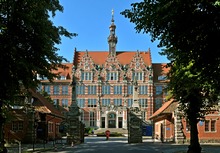


Higher education
| Name | Location | Students in thousands | |
| total | of which women | ||
| Total | - | 97.9 | 55.3 |
| Uniwersytet Gdański (Gdańsk University) |
Tricity | 29.3 | 19.4 |
| Politechnika Gdańska (Gdańsk University of Technology) |
Gdańsk | 17.6 | 5.9 |
| Akademia Pomorska w Słupsku (Pomeranian Academy in Słupsk) |
Słupsk | 8.1 | 6.0 |
| Akademia Medyczna w Gdańsku (Medical University of Gdańsk) |
Gdańsk | 4.2 | 3.1 |
| Akademia Wychowanie Fizycznego i Sportu w Gdańsku (Gdańsk Sports Academy) |
Gdańsk | 4.1 | 1.9 |
| Akademia Sztuk Pięknych w Gdańsku (Gdańsk Academy of Fine Arts) |
Gdańsk | 0.9 | 0.7 |
| Akademia Marynarki Wojennej im. Bohaterów Westerplatte (Polish Naval Academy) |
Gdynia | . | . |
| Akademia Morska w Gdyni (Gdynia Maritime Academy) |
Gdynia | . | . |
| Gdańskie Seminarium Duchowne (Gdańsk Seminary) |
Gdańsk | . | . |
| Akademia Muzyczna im. Stanisława Moniuszki w Gdańsku (Stanisław Moniuszko Academy of Music, in Gdańsk) |
Gdańsk | . | . |
| Data as of 31 November 2005, source http://www.stat.gov.pl | |||
Protected areas

Protected areas in Pomeranian Voivodeship include two National Parks and nine Landscape Parks. These are listed below.
- Słowiński National Park (a UNESCO-designated biosphere reserve)
- Tuchola Forest National Park (part of a UNESCO-designated biosphere reserve)
- Coastal Landscape Park
- Iława Lake District Landscape Park (partly in Warmian-Masurian Voivodeship)
- Kashubian Landscape Park
- Słupia Valley Landscape Park
- Tricity Landscape Park
- Tuchola Landscape Park (partly in Kuyavian-Pomeranian Voivodeship)
- Vistula Spit Landscape Park
- Wdydze Landscape Park
- Zaborski Landscape Park
Gallery
- Cathedral Basilica of the Assumption, Pelplin
- Malbork Castle, a UNESCO World Heritage Site
- The Gothic New Gate in Słupsk
- Neptune's Fountain and the Long Market in Gdańsk
- Royal Chapel in Gdańsk
- Museum of the National Anthem in Będomin
- Pier in Sopot, the longest wooden pier in Europe
- Road bridge in Tczew, built as the longest bridge in Europe in the mid-19th-century
- Dar Pomorza in Gdynia
References
- "Sub-national HDI - Subnational HDI - Global Data Lab". globaldatalab.org. Radboud University Nijmegen. Retrieved 2021-12-13.
- Arkadiusz Belczyk,Tłumaczenie polskich nazw geograficznych na język angielski Archived 2016-03-03 at the Wayback Machine [Translation of Polish Geographical Names into English], 2002-2006.
- Der Name Pommern (po more) ist slawischer Herkunft und bedeutet so viel wie „Land am Meer“. (Pommersches Landesmuseum, German)
- GUS. "Population. Size and structure and vital statistics in Poland by territorial division in 2019. As of 30th June". stat.gov.pl. Retrieved 2020-09-11.
- "Regional GDP per capita ranged from 30% to 263% of the EU average in 2018". Eurostat. Archived from the original on 2022-10-10.
- "Archived copy" (PDF). Archived from the original (PDF) on 2006-12-31. Retrieved 2007-01-22.
{{cite web}}: CS1 maint: archived copy as title (link)
External links
- Information about Pomeranian Voivodeship - official website (pl, en, ru)
- Economy brochure (en)
- The Pomorskie Voivodeship. The Greatest Tourist Attractions - Brochure (en)
- Pomerania Development Agency Co. (en)
На других языках
- [en] Pomeranian Voivodeship
[ru] Поморское воеводство
Поморское воеводство (польск. Województwo pomorskie, кашубск. Pòmòrsczé wòjewództwò) — воеводство, расположенное на севере Польши. Административным центром и крупнейшим городом является город Гданьск.Другой контент может иметь иную лицензию. Перед использованием материалов сайта WikiSort.org внимательно изучите правила лицензирования конкретных элементов наполнения сайта.
WikiSort.org - проект по пересортировке и дополнению контента Википедии


